Streacom's FC10 and Nano150: Building a Fanless Ivy Bridge HTPC
by Ganesh T S on December 22, 2012 3:30 AM EST- Posted in
- HTPC
- Fanless
- Ivy Bridge
Thermal Performance
Evaluation of the thermal performance of passive systems is absolutely essential because it is quite common for improperly designed thermal solutions to not prevent processors from reaching their maximum permissible junction temperature. Once this temperature is reached, thermal throttling is activated. The processor first reacts by lowering its operating frequency. If the cooling solution is bad, it might even result in the processor shutting itself down.
The Streacom OEM solution used in the Aleutia Relia wasn't very effective (though Streacom refused to comment on those results). However, their previous chassis / cooling solutions had always been effective in operation, and we weren't unduly worried about the FC10 with respect to this aspect. That said, we did carry out the same experiments performed with the Aleutia Relia, but restricted ourselves to room temperature (72 F = 22 C) tests only.
Our loading test consists of running Prime 95 in maximum power consumption mode along with Furmark in Stability Test mode. Instead of running the test for 20 minutes, we subjected the unit to 12 hours of stress continuously.
Power consumed at the wall was recorded for the first 90 minutes or so (and we found that it settled down to around 72 W beyond that). Unlike the Relia where thermal throttling was activated and resulted in power consumption at the wall going down after some time, we find that there is no thermal throttling at play in this system. The load and CPU frequencies were presented in the Relia review, but we won't present them here since the load stayed at 100% and the frequency of the cores was always at 3.3 GHz throughout the course of the stress test.
The CPU core temperatures are presented in the graphs above. Interestingly, the second core was always a couple of degrees cooler than the first core. The maximum junction temperature of the Core i3-3225 is 105 C, and the FC10 cooling mechanism was able to keep it at a safe temperature.
Another interesting aspect is how fast the unit is able to get back to the idle temperature after removal of the processor load. The graph below shows that the unit gets back to the idling temperature within 90 minutes.
We conclude this section with a thermal profile of the case and the heat sink when the unit is being subjected to full load using Prime 95 and Furmark. All the temperatures are in Farenheit.
The temperature on the lower CPU mount noted above was actually on top of the FC10 upper CPU mount (Intel-type). All these values were recorded with the unit being kept in a still room with plenty of open space around it.




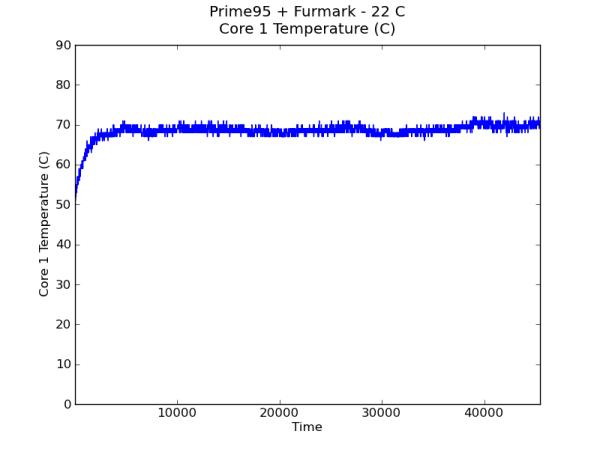
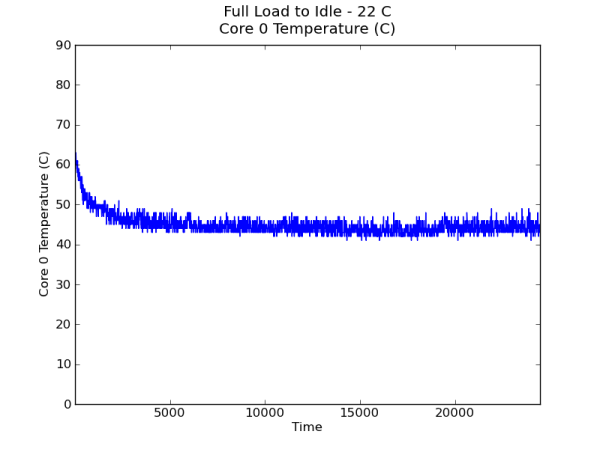
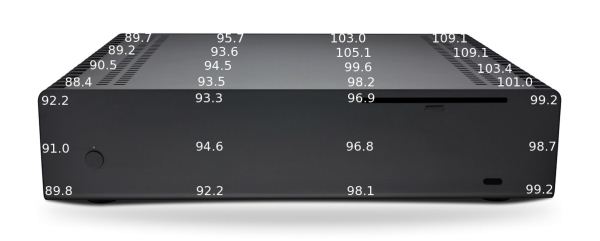
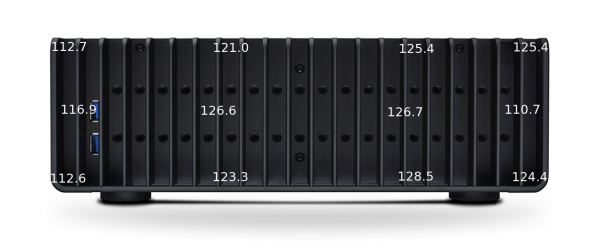

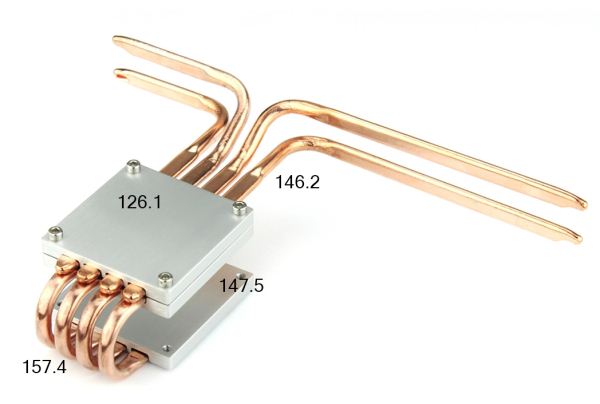








63 Comments
View All Comments
brakteat - Saturday, December 22, 2012 - link
LauRoman is right. Last year I built four fanless computers for our office, using HD-Plex H3.S chassis. Since then they run fast (Core i3-2105+SSD), completely silently (no moving parts) and still very cool (under load, all components are usually below 55 C). Also, after one year there is no visible dust inside the chassis so there is no need for physical maintenance.Of course, if you want to play games at high resolution then HD 4000 is certainly not enough (and my HD 3000 even less so). I always play my games at 2560x1600 and built myself an inaudible gaming computer in a Coolermaster HAF-X. This works great thanks to seven large fans running at low speed. The graphics card is ony cooled by a 200 mm fan. The fans do collect a lot of dust though, even if the case has dust filters. Without maintenance the dust would eventually stop the computer from working.
EnzoFX - Saturday, December 22, 2012 - link
TRUE. The single best reason to go for passive is no dust. Can't argue against someone wanting zero maintenance.Death666Angel - Saturday, December 22, 2012 - link
I have an HTPC with one fan that serves double duty as the cpu heatsink fan and the case fan (I cut a large hole above into the case above the heatsink so the fan could get fresh air), I also have a dust cover just above it that works with magnets. Every time my wife or I vacuum the living room, we just take it off, vacuum it as well and put it back on. nearly zero maintenance and much more powerful if I wanted to. Also, silent in the current setup. I would never go with a fanless case.But I do see that for some people/situations, adding fans does not bring anything to the table because they just don't need the power or cooler running components. :)
EnzoFX - Saturday, December 22, 2012 - link
Yes exactly. Some people really want zero maintenance, and aren't going to be gaming on it =P. I myself am drawn to such a setup, but I've never been able to commit, and probably never will. So it does go to show that it's impractical for more hands-on users, seeing as with just a little work, you get much more in return.colonelciller - Sunday, December 23, 2012 - link
this case is perfect for playing 1080 P video streamed from a home media server (in another room).looks like a ZERO compromise machine to people who want silence.
For those who want a do-it-all noise maker next to there TV there are other cases.
ryccoh - Saturday, December 22, 2012 - link
Check out Silverstone cases. They like to mount two slow 180mm fans on the buttom blowing air out the top of the case with the motherboard turned 90 degrees.colonelciller - Sunday, December 23, 2012 - link
No no no absolutely NOTThe whole point of this case is silence with a capital 'S'.
The case is perfect as is. Even the quietest fans are not silent which is a complete FAIL for those seeking true Silence from the HTPC.
Couple this case with an efficient cpu with integrated graphics and a small SSD for OS only and you've got perfection.
Store all your media on a home server where it belongs. As soon as you try to turn a HTPC into a do-it-all machine you start making compromises.
CaioRearte - Saturday, December 22, 2012 - link
Hello, please evaluate how this build would turn out powered by one of AMD Trinity's APUs. They have 65W parts that can be passively-cooled and it might be interesting to see how the IGP performs, especially since Intel's integrated graphics don't perform at all.kyuu - Saturday, December 22, 2012 - link
+1random2 - Saturday, December 22, 2012 - link
Yes, but the i3-3225 sure performs. The integrated graphics on these APUs get their butts handed to them on a platter by the lowly 640 GPU used here. Added to that is the fact that CPUs do make a difference in times for individual frame rendering and in game frame rates.http://techreport.com/review/23246/inside-the-seco...